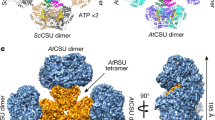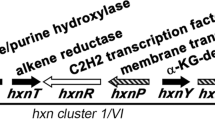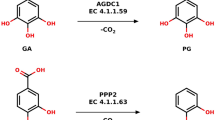Abstract
Opine dehydrogenases catalyze the NAD(P)H-dependent reversible reaction to form opines that contain two asymmetric centers exhibiting either (L,L) or (D,L) stereochemistry. The first structure of a (D,L) superfamily member, N-(1-D-carboxylethyl)-L-norvaline dehydrogenase (CENDH) from Arthrobacter sp. strain 1C, has been determined at 1.8 Å resolution and the location of the bound nucleotide coenzyme has been identified. Six conserved residues cluster in the cleft between the enzyme's two domains, close to the nucleotide binding site, and are presumed to define the enzyme's catalytic machinery. Conservation of a His-Asp pair as part of this cluster suggests that the enzyme mechanism is related to the 2-hydroxy acid dehydrogenases. The pattern of sequence conservation and substitution between members of this enzyme family has permitted the tentative location of the residues that define their differential substrate specificities.
This is a preview of subscription content, access via your institution
Access options
Subscribe to this journal
Receive 12 print issues and online access
$189.00 per year
only $15.75 per issue
Buy this article
- Purchase on Springer Link
- Instant access to full article PDF
Prices may be subject to local taxes which are calculated during checkout






Similar content being viewed by others
Accession codes
References
Thompson, J. & Donkersloot, J.A. N-(carboxylalkyl)amino acids: occurrence, synthesis and functions. Ann. Rev. Biochem. 61, 517–557 (1992).
Bevan, M. Barnes, W.M. & Chilton, M.D. Structure and transcription of the nopaline synthase gene region of T-DNA. Nucleic Acids Res. 11, 369–385 (1983).
Barker, R.F., Idler, K.B., Thompson, D.V. & Chilton, M.D. Nucleotide sequence of the T-DNA region from the Agrobacterium tumefaciens octopine Ti plasmid PTI15955. Plant Mol. Biol. 2, 335 –350 (1983).
Asano, Y., Yamaguchi, K. & Kondo, K. A new NAD+-dependent opine dehydrogenase from Arthrobacter sp. Strain 1C. J. Bacteriol. 171, 4466 –4471 (1989).
Xuan, J. -W., Fournier, P., DeClerck, N., Chasles, M. & Gaillardin, C. Overlapping reading frames at the Lys5 locus in the yeast Yarrowia lipolytica. Mol. Cell Biol. 10 , 4795–4806 (1990).
Donkersloot, J.A. & Thompson, J. Cloning, expression, sequence-analysis and site-directed-mutagenesis of the TN5306-encoded N-5(carboxylethyl)ornithine synthase from Lactococcus lactis K1. J. Biol. Chem. 270, 12226–12234 (1995).
Thompson, J. & Miller, S.P.F. N-5-(1-carboxylethyl)ornithine and related [N-carboxylalkyl]-amino acids - structure, biosynthesis and function . Adv. Enz. 64, 317–399 (1991).
Drummond, M. Crown gall disease . Nature 281, 343–347 (1979).
Smith, E.F. & Townsend, C.O. A plant-tumour of bacterial origin . Science 25, 671–673 (1907).
DeGreve, H., Decraemer, H., Seurinck, J., Vanmontagu, M. & Schell, J. The functional organisation of the octopine Agrobacterium tumefaciens plasmid PTIB6S3. Plasmid 6, 235–248 (1981).
Chilton, M.D. et al. Stable incorporation of plasmid DNA into higher plant cells: the molecular basis of crown gall tumorigenesis. Cell 11, 263–271 (1977).
Veluthambi, K., Krishnan, M., Gould, J.H., Smith, R.H. & Gelvin, S.B. Opines stimulate induction of the vir genes of the Agrobacterium tumefaciens Ti plasmid. J. Bacteriol. 171, 3696–3703 (1989).
Kato, Y., Yamada, H. & Asano, Y. Stereoselective synthesis of opine-type secondary amine carboxylic acids by a new enzyme opine dehydrogenase. Use of recombinant enzymes. J. Mol. Catal. B1 151–160 (1996).
Dairi, T. & Asano, Y. Cloning, nucleotide sequencing, and expression of an opine dehydrogenase gene from Arthrobacter sp. Strain 1C. Appl. Environ. Microbiol. 61, 3169– 3171 (1995).
Laskowski, R.A., MacArtur, M.W., Moss, D.S. & Thorton, J.M.J. PROCHECK — A program to check the stereochemical quality of protein structures. Appl. Crystallogr. 26, 283– 291 (1993).
Rossmann, M.G., Moras, D. & Olsen, K.W. Chemical and biological evolution of a nucleotide-binding protein. Nature 250, 194– 199 (1974).
Wierenga, R.K., De Maeyer, M.C.H. & Hol, W.G.J. Interactions of pyrophosphate moieties with α-helices in dinucleotide binding proteins. Biochemistry 24, 1346–1357 (1985).
Lee, B & Richards, F.M. The interpretation of protein structures; estimation of static accessibility. J. Mol. Biol. 55 , 379–400 (1971).
Jones, S. & Thornton, J.M. Protein–protein interactions: a review of protein dimer structures. Prog. Biophys. Mol. Biol. 63, 31–65 ( 1995).
Abad-Zapatero, C., Griffith, J.P., Sussman, J.L. & Rossmann, M.G. Refined crystal structure of dogfish M = 4 = apo-lactate dehydrogenase. J. Mol. Biol. 198, 445–467 (1987).
Baker, P.J., Britton, K.L., Rice, D.W., Rob, A. & Stillman, T.J. Structural consequences of sequence patterns in the fingerprint region of the nucleotide binding fold.Implications for nucleotide specificity . J. Mol. Biol. 228, 662– 671 (1992).
Grindley, H.M., Artymiuk, P.J., Rice, D.W. & Willett, P. Identification of tertiary structure resemblance in proteins using a maximal common subgraph isomorphism algorithm. J. Mol. Biol. 229, 707–721 (1993).
Bernstein, F.C. et al. The protein data bank: a computer-based archival file for molecular structures . J. Mol. Biol. 112, 535– 542 (1977).
Adams M.J., Ellis, G.H., Gover, S., Naylor, C.E., & Phillips, C. Crystallographic study of coenzyme, coenzyme analog and substrate-binding in 6-phosphogluconate dehydrogenase — implications for NADP specificity and the enzyme mechanism. Structure 2, 651–668 (1994).
Rosemeyer, M.A. The biochemistry of glucose-6-phosphate dehydrogenase, 6-phosphogluconate dehydrogenase and glutathione reductase. Cell Biochem. Funct. 5, 79–95 (1987).
Monneuse, M.-O. & Rouzé, P . Sequence comparisons between Agrobacterium tumefaciens T-DNA-encoded octopine and nopaline dehydrogenases and other nucleotide-requiring enzymes: structural and evolutionary implications . J. Mol. Evol. 25, 46– 57 (1987).
Gä de, G. & Grieshaber, M.K. Pyruvate reductases catalyse the formation of lactate and opines in anaerobic invertebrates. Comp. Biochem. Physiol. 83B, 255–272 (1986).
Hart, K.W. et al. The importance of arginine 171 in substrate binding by Bacillus stearothermophilus lactate dehydrogenase. Biochem. Biophys. Res. Commun. 146, 346–353 (1987).
Clarke, A.R. et al. An investigation of the contribution made by the carboxylate group of an active site histidine-aspartate couple to binding and catalysis in lactate dehydrogenase . Biochemistry 27, 1617– 1622 (1988).
Phillips, C., Gover, S. & Adams, M.J. Structure of 6-phosphogluconate dehydrogenase refined at 2Å resolution . Acta Crystallogr. D 51, 290– 304 (1995).
Goldberg, J.D., Yoyokazu, T. & Brick, P. Crystal structure of a NAD-dependent D-glycerate dehydrogenase at 2.4 Å resolution. J. Mol. Biol., 236, 1123–1140 (1994).
Stillman, T.J., Baker, P.J., Britton, K.L. & Rice, D.W. Conformational flexibility in glutamate dehydrogenase.Role of water in substrate recognition and catalysis. J. Mol. Biol. 234, 1131– 1139 (1993).
Baker, P.J. et al. Analysis of the structure and substrate binding of Phormidium lapideum alanine dehydrogenase. Nature Struct. Biol. 5, 561–567 (1998).
Britton, K.L. et al. Crystallization of Arthrobacter sp. Strain 1C opine dehydrogenase and its complex with NAD+. Acta Crystallogr. D54 124–126 (1998).
Hamlin, R. Multiwire area X-ray diffractometers. Meth. Enz. 114, 416 –452 (1985).
Xuong, N.H., Nielsen, C., Hamlin, R. & Anderson, D. Strategy for data collection from protein crystals using a multiwire counter area detector diffractometer . J. Appl. Crystallogr. 18, 342– 350 (1985).
Howard, A.J., Nielsen, C. & Young, N.H. Software for a diffractometer with multiwire area detector. Meth. Enz. 114, 452–472 ( 1985).
Leslie, A.G.W. Recent changes to the MOSFLM package for processing film and image data. In Joint CCP4 and ESF-EADBM Newsletter on Protein Crystallography, no. 26. (SERC Daresbury Laboratory, Warrington, UK; 1992).
Collaborative Computing Project No. 4.The CCP4 suite: programs for protein crystallography. Acta Crystallogr. D 50 , 760–763 (1994).
Otwinowski, Z. Maximum likelihood refinement of heavy atom parameters in isomorphous replacement and anomalous scattering. In Proceedings of the CCP4 Study Weekend. (eds Wolf, W., Evans, P.R. and Leslie, A.G.W.) 80–86 (SERC Daresbury Laboratory, Warrington, UK; 1991).
Cowtan, K. DM an automated procedure for phase improvement by density modification. In Joint CCP4 and ESF-EACBM Newsletter on Protein Crystallography no. 31. 34–38 (SERC Laboratory, Daresbury, Warrington, WA4 4AD, UK; 1994).
Jones, T.A., Zou, J.Y., Cowan, S.W. & Kjeldgaard, M. Improved methods for the building of protein models in electron density maps and the location of errors in these models. Acta Crystallogr. A47, 110–119 (1991).
Jones, T.A. Interactive computer graphics: FRODO. Meth. Enz. 115, 157– 171 (1985).
Tronrud, D.E., Ten Eyck, L.F. & Matthews, B.W. An efficient general-purpose least squares refinement program for macromolecular structures. Acta Crystallogr. A43, 489–501 (1987).
Tronrud, D.E. Conjugate-direction minimisation: an improved method for the refinement macromolecules. Acta Crystallogr. A48, 912–916 (1992).
Moews, P.C. & Kretsinger, R.H. Refinement of the structure of carp muscle calcium-binding parvalbumin by model building and difference Fourier analysis. J. Mol. Biol. 91, 201– 228 (1975).
Mitchell, E.M., Artymiuk, P.J., Rice, D.W. & Willett, P. Use of techniques derived from graph theory to compare secondary structure motifs in proteins. J. Mol. Biol. 212, 151 –166 (1990).
Bron, C. & Kerbosch, J. Algorithm 457—finding all cliques of an undirected graph. Commun. ACM 16, 575–577 (1973).
Kraulis, P.J. MOLSCRIPT: a program to produce both detailed and schematic plots of protein structures . J. Appl. Crystallogr. 24, 946– 950 (1991).
Ferrin, T.E., Huang, C.C., Jarvis, L.E. & Langridge, R. The MIDAS display system. J. Mol. Graphics 6, 13– 27 (1988).
Esnouf, R.M. An extensively modified version of Molscript that includes greatly enhanced colouring capabilities . J. Mol. Graphics 15, 113– 138 (1997).
Acknowledgements
We thank the support staff at the Synchrotron Radiation Source at CCLRC Daresbury Laboratory for assistance with station alignment. This work was supported by grants from The Wellcome Trust, EU, New Energy and Industrial Development Organisation and International Scientific Research (Joint Research), supported by The Ministry of Education, Science, Sports and Culture of Japan. We acknowledge an award of a travel grant under The British Council/The Royal Society/JSPS Anglo-Japanese Scientific Exchange Scheme. The Krebs Institute is a designated BBSRC Biomolecular Sciences Centre and a member of the North of England Structural Biology Centre (NESBIC).
Author information
Authors and Affiliations
Corresponding author
Rights and permissions
About this article
Cite this article
Britton, K., Asano, Y. & Rice, D. Crystal structure and active site location of N-(1-D-carboxylethyl)-L-norvaline dehydrogenase. Nat Struct Mol Biol 5, 593–601 (1998). https://doi.org/10.1038/854
Accepted:
Issue Date:
DOI: https://doi.org/10.1038/854



